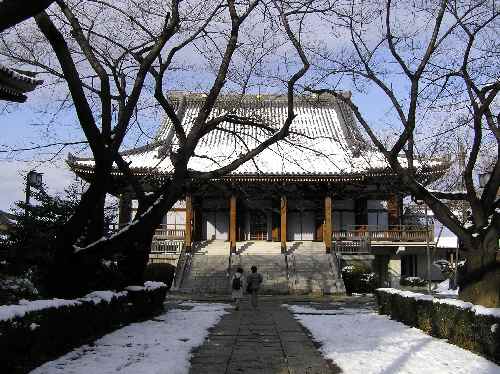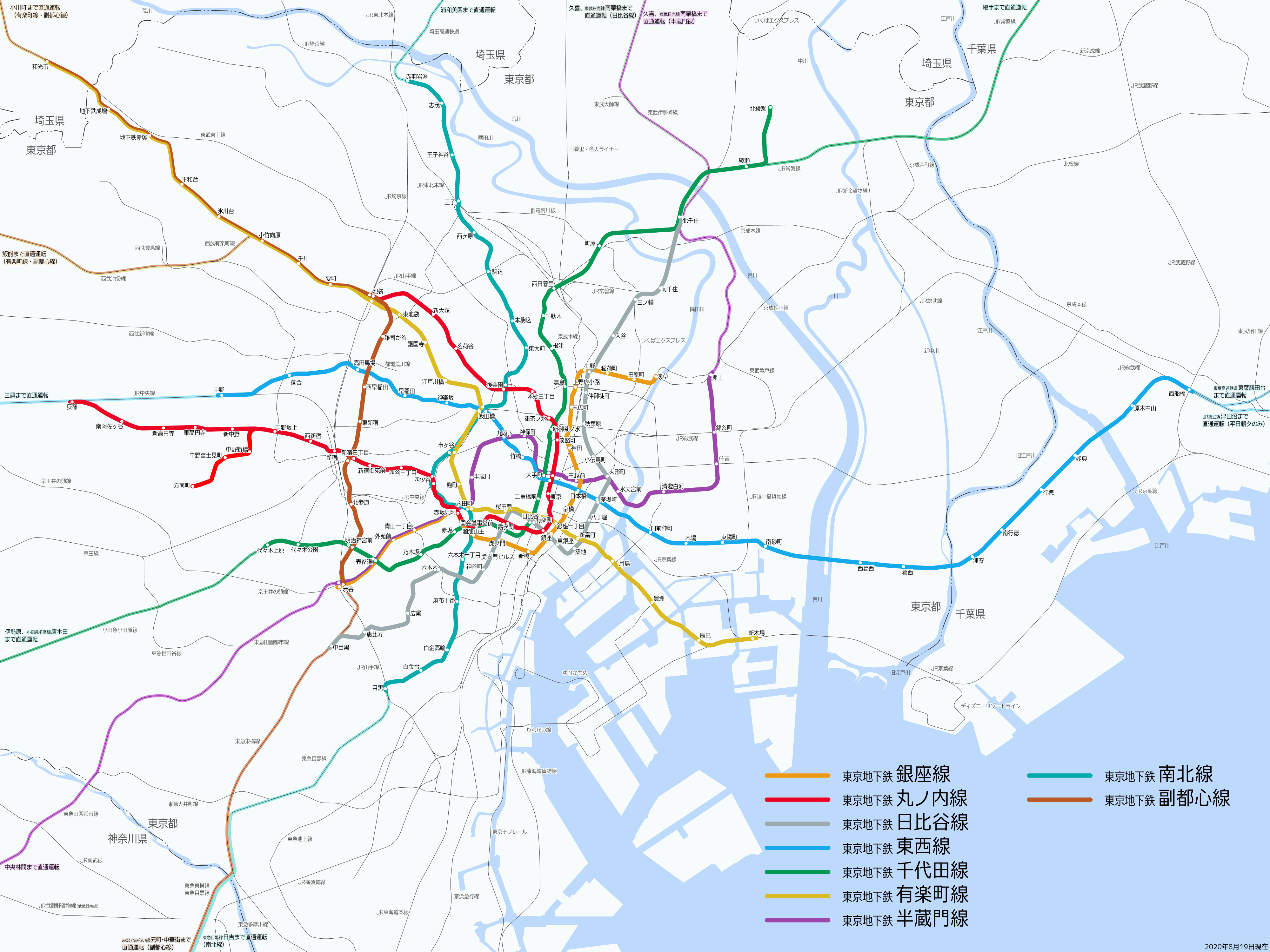|
Shin-ōtsuka Station
is a subway station in Bunkyō, Tokyo, Japan, operated by Tokyo Metro. Its station number is M-24. The station opened on 20 January 1954, and consists of two side platforms. Lines Shin-ōtsuka Station is served by the Tokyo Metro Marunouchi Line The is a subway line in Tokyo, Japan, operated by Tokyo Metro. The line runs in a U-shape between Ogikubo Station in Suginami and Ikebukuro Station in Toshima, with a branch line between Nakano-Sakaue Station and Hōnanchō Station. The offi .... Station Layout The station consists of two underground side platforms, with separate ticket gates for the corresponding platforms. In 2011, a connecting passage was completed to connect the two ticket gates together and the gates for platform 1 was renamed as the North gate and that for platform 2 as the South gate. Platforms File:TokyoMetro-M24-Shin-otsuka-station-platform-20170817-123420.jpg, Platforms, 2017 Surroundings * Ōtsuka Station * Mukōhara Station * Asahi Shinkin Ban ... [...More Info...] [...Related Items...] OR: [Wikipedia] [Google] [Baidu] |
Bunkyō
is a special ward located in Tokyo, Japan. Situated in the middle of the ward area, Bunkyō is a residential and educational center. Beginning in the Meiji period, literati like Natsume Sōseki, as well as scholars and politicians have lived there. Bunkyō is home to the Tokyo Dome, Judo's Kōdōkan, and the University of Tokyo's Hongo Campus. Bunkyō has a sister-city relationship with Kaiserslautern in the Rhineland-Palatinate of Germany. It was formed in 1947 as a merger of Hongo and Koishikawa wards following Tokyo City's transformation into Tokyo Metropolis. The modern Bunkyo ward exhibits contrasting Shitamachi and Yamanote geographical and cultural division. The Nezu and Sendagi neighborhoods in the ward's eastern corner is attached to the Shitamachi area in Ueno with more traditional Japanese atmosphere. On the other hand, the remaining areas of the ward typically represent Yamanote districts. As of May 1, 2015, the ward has a population of 217,743 (includin ... [...More Info...] [...Related Items...] OR: [Wikipedia] [Google] [Baidu] |
Tokyo
Tokyo (; ja, 東京, , ), officially the Tokyo Metropolis ( ja, 東京都, label=none, ), is the capital and List of cities in Japan, largest city of Japan. Formerly known as Edo, its metropolitan area () is the most populous in the world, with an estimated 37.468 million residents ; the city proper has a population of 13.99 million people. Located at the head of Tokyo Bay, the prefecture forms part of the Kantō region on the central coast of Honshu, Japan's largest island. Tokyo serves as Economy of Japan, Japan's economic center and is the seat of both the Government of Japan, Japanese government and the Emperor of Japan. Originally a fishing village named Edo, the city became politically prominent in 1603, when it became the seat of the Tokugawa shogunate. By the mid-18th century, Edo was one of the most populous cities in the world with a population of over one million people. Following the Meiji Restoration of 1868, the imperial capital in Kyoto was mov ... [...More Info...] [...Related Items...] OR: [Wikipedia] [Google] [Baidu] |
Side Platforms
A side platform (also known as a marginal platform or a single-face platform) is a platform positioned to the side of one or more railway tracks or guideways at a railway station, tram stop, or transitway. A station having dual side platforms, one for each direction of travel, is the basic design used for double-track railway lines (as opposed to, for instance, the island platform where a single platform lies between the tracks). Side platforms may result in a wider overall footprint for the station compared with an island platform where a single width of platform can be shared by riders using either track. In some stations, the two side platforms are connected by a footbridge running above and over the tracks. While a pair of side platforms is often provided on a dual-track line, a single side platform is usually sufficient for a single-track line. Layout Where the station is close to a level crossing (grade crossing) the platforms may either be on the same side of the cro ... [...More Info...] [...Related Items...] OR: [Wikipedia] [Google] [Baidu] |
Tokyo Metro
The is a major rapid transit system in Tokyo, Japan, operated by the Tokyo Metro Co. With an average daily ridership of 6.84 million passengers, the Tokyo Metro is the larger of the two subway operators in the city; the other being the Toei Subway, with 2.85 million average daily rides. Organization Tokyo Metro is operated by , a joint-stock company jointly owned by the Government of Japan and the Tokyo Metropolitan Government. The company, founded as a part of then-Prime Minister Junichiro Koizumi's policy of converting statutory corporations into joint-stock companies, replaced the , commonly known as Eidan or TRTA, on April 1, 2004. TRTA was administered by the Ministry of Land, Infrastructure and Transport, and jointly funded by the national and metropolitan governments. It was formed in 1941 as a part-nationalization of the Tokyo Underground Railway and Tokyo Rapid Railway (now both form the Tokyo Metro Ginza Line), although its oldest lines date back to 1927 wi ... [...More Info...] [...Related Items...] OR: [Wikipedia] [Google] [Baidu] |
Tokyo Metro Marunouchi Line
The is a subway line in Tokyo, Japan, operated by Tokyo Metro. The line runs in a U-shape between Ogikubo Station in Suginami and Ikebukuro Station in Toshima, with a branch line between Nakano-Sakaue Station and Hōnanchō Station. The official name is . The line was named after the Marunouchi business district in Chiyoda, Tokyo, under which it passes. On maps, diagrams and signboards, the line is shown using the color red (), and its stations are given numbers using the letters "M" for the main line and "Mb" for the branch line. Overview The Marunouchi Line is the second line to be built in the city, and the first one constructed after the Second World War. The route is U-shaped, running from Ogikubo Station in the west of the city via the commercial and administrative district of Shinjuku through to the Marunouchi commercial center around Tokyo Station, before turning back and heading to Ikebukuro. Along with the Ginza Line, it is self-enclosed and does not have any thro ... [...More Info...] [...Related Items...] OR: [Wikipedia] [Google] [Baidu] |
Ōtsuka Station
is a railway station in Toshima, Tokyo, Japan, operated by East Japan Railway Company (JR East). Lines Ōtsuka Station is served by the circular Yamanote Line. A stop on the Tokyo Sakura Tram, named is located underneath Ōtsuka Station. Station layout The station consists of an elevated island platform serving the two Yamanote Line tracks. The station has a ''Midori no Madoguchi'' staffed ticket office. Chest-high platform edge doors were installed on the Yamanote Line platforms, brought into use from 20 April 2013. File:JR Otuska sta 002.jpg, The south entrance, April 2010 File:JR_Yamanote-Line_Otsuka_Station_Gates.jpg, JR East ticket gates, September 2019 File:JR_Yamanote-Line_Otsuka_Station_Platform.jpg, The Yamanote line platforms, September 2019 Platforms History The station opened on 1 April 1903. The wooden station structure on the south side was demolished in 2009. Passenger statistics In fiscal 2010, the station was used by an average of 53,346 passengers ... [...More Info...] [...Related Items...] OR: [Wikipedia] [Google] [Baidu] |
Mukōhara Station
is a Tokyo Sakura Tram station located in Toshima, Tokyo, Japan. Lines *Tokyo Sakura Tram The , branded as the , is a hybrid light rail/tram line in Tokyo, Japan, operated by the Tokyo Metropolitan Bureau of Transportation (Toei). The Arakawa Line is the sole survivor of Tokyo's once-extensive Tokyo Toden streetcar system. It is one ... References Railway stations in Tokyo Railway stations in Japan opened in 1925 {{Tokyo-railstation-stub ... [...More Info...] [...Related Items...] OR: [Wikipedia] [Google] [Baidu] |
Asahi Shinkin Bank
is a bank founded in 1923 and based in Tokyo, Japan. It was established on 3 August 1923. , the bank has 164 branches in Tokyo, Saitama, and Chiba Prefecture is a prefecture of Japan located in the Kantō region of Honshu. Chiba Prefecture has a population of 6,278,060 (1 June 2019) and has a geographic area of . Chiba Prefecture borders Ibaraki Prefecture to the north, Saitama Prefecture to the ...s. The bank offers customers housing loans, car loans, and loans to finance education, as well as services to companies doing business internationally. , the bank was planning to offer reverse mortgages to customers. See also * List of banks * List of banks in Japan References External links * Banks of Japan 1923 establishments in Japan Financial services companies based in Tokyo {{Bank-stub ... [...More Info...] [...Related Items...] OR: [Wikipedia] [Google] [Baidu] |
Toho Junior College Of Music
is a private junior college A junior college (sometimes referred to colloquially as a juco, JuCo or JC) is a post-secondary educational institution offering vocational training designed to prepare students for either skilled trades and technical occupations and workers in su ... in Bunkyo, Tokyo, Japan. History The college opened in April 1951, but the predecessor of the school, Mimurodo Education Group, was founded in 1938. The junior college is not attached to Toho College of Music. External links * {{authority control Educational institutions established in 1951 Japanese junior colleges 1951 establishments in Japan Universities and colleges in Tokyo Private universities and colleges in Japan ... [...More Info...] [...Related Items...] OR: [Wikipedia] [Google] [Baidu] |
Railway Stations In Japan Opened In 1954
Rail transport (also known as train transport) is a means of transport that transfers passengers and goods on wheeled vehicles running on rails, which are incorporated in tracks. In contrast to road transport, where the vehicles run on a prepared flat surface, rail vehicles (rolling stock) are directionally guided by the tracks on which they run. Tracks usually consist of steel rails, installed on sleepers (ties) set in ballast, on which the rolling stock, usually fitted with metal wheels, moves. Other variations are also possible, such as "slab track", in which the rails are fastened to a concrete foundation resting on a prepared subsurface. Rolling stock in a rail transport system generally encounters lower frictional resistance than rubber-tyred road vehicles, so passenger and freight cars (carriages and wagons) can be coupled into longer trains. The operation is carried out by a railway company, providing transport between train stations or freight customer facilit ... [...More Info...] [...Related Items...] OR: [Wikipedia] [Google] [Baidu] |





